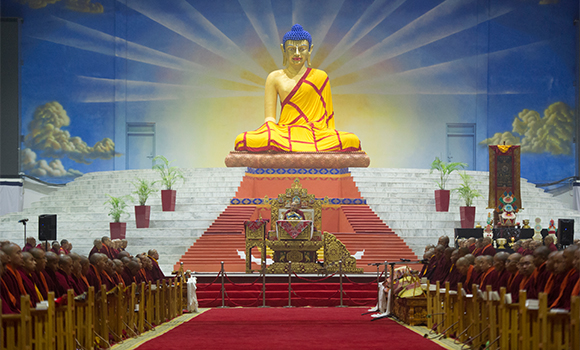 Four-Armed Mahakala: Protector of the Marpa Kagyu
Four-Armed Mahakala: Protector of the Marpa Kagyu
5 and 6 February, 2016 -Monlam Pavillion, Bodhgaya,
By Friday morning, the beginning of the main practice, some noticeable changes had occurred at the pavillion. At 10.00pm the previous evening His Holiness the Karmapa had personally draped a golden silk robe over the Buddha statue. In addition, a gilded and decorated throne, higher and more ornate than the simple throne used on the first day, had been brought over from Tergar shrine room and now stood centre stage. A thangka of Four-Armed Mahakala hung over the offerings table which had been moved to the right of the Karmapa’s throne. The rows of maroon-clad monks and nuns had increased. Stretching out to either side behind the musicians and umzes, they now reached to the very edges of the pavillion. At their head sat the Vajra Master Gyaltsen Namgyal and Chief Khenpo Lobsang Nyima, both from Rumtek Monastery in Sikkim, which is preserving this Four-Armed Mahakala tradition at the behest of the 17th Karmapa.
The puja began promptly at 6.00am when the umzes’ deep, slow chant of the prayer to Guru Rinpoche resonated across the huge auditorium for several minutes. Guru Rinpoche, who brought Buddhism to Tibet and subdued native hostile forces, is always invoked at the beginning of yidam and protector practices. This was followed by the Chakrasamvara self-visualisation sadhana, visualisation of the 13 yidam deities, and then the main practice of Four-Armed Mahakala with torma offerings, using a text compiled by Karma Chakme, and including a short prayer composed by the 17th Karmapa.
The Dharma protector Mahakala – the Great Black One – is seen as the wrathful aspect of Avalokiteshvara, the bodhisattva of compassion. He is the King of the Dharmapalas, fierce and powerful, destroying negativity, clearing away obstacles, and eliminating adverse conditions. He defends the Dharma from corruption and degeneration, destroys its enemies all forces hostile to it and, at the level of the individual practitioner, guides and protects them from all kinds of deception and delusion. For this reason, the Short Mahakala ritual is a daily practice in Karma Kagyu monasteries and nunneries.
Mahakala has several forms. The two-armed form, Bernakchen, is the Dharma protector associated with the Karmapas and the Karma Kamtsang. The four-armed form is associated with all the lineages of the Marpa Kagyu, including the Karma Kagyu, the Drukpa Kagyu and the Drikung Kagyu, and is also important in the Nyingma tradition. The six-armed form is important for Geluk practitioners.
However, all the Mahakala practices in Tibetan Buddhism originate from Palchen Galo Namgyal Dorje, also known as Ga Lotsawa, who studied in India and brought back many precious Buddhist teachings including the Mahakala practices. He received two different transmissions: one from a Minyak lama in Bodhgaya and one from Abhayakaragupta, the great teacher from Vikramashila Monastic University, who also taught in Bodhgaya. Having received the empowerments and instructions, Palchen Galo went to what is known as the Mahakala Cave near Bodhgaya, practised intensively, and having accomplished the practice, had a vision of Mahakala. Returning to Tibet, he became the yongzin (tutor) of Dusum Khyenpa, and gave the transmission and instructions of the Mahakala practices to him. Thus, the practices entered the Karma Kagyu tradition.
For some time, the 17th Gyalwang Karmapa had wanted to offer a Four-Armed Mahakala practice at the Gutor Chenmo, and the decision to do that this year was made at the beginning of 2015, shortly after the 32nd Kagyu Monlam. According to His Holiness, to offer this practice in 2016, when monks, nuns and lay-practitioners had gathered in large numbers in Bodhgaya before the Monlam, would benefit the Buddhist teachings, the teachings of the Karma Kamtsang in particular, and the activities of the Karmapas. Consequently, a letter was sent to all Kagyu monasteries and nunneries summoning them to Bodhgaya for the Gutor Chenmo and requesting them to complete their own Gutor either before they came or afterwards.
Sustained by butter tea, sweet tea, hot watered milk, bread, rice porridge and wheat meal rolls, monks, nuns and lay-practitioners joined in the ritual for two days from 6.00am to 6.00pm, punctuated by a three hour lunch break.
On Saturday, however, the ritual was halted momentarily. Just after lunch, a small truck brought the body of a Tibetan woman, accompanied by several monks. The woman had come on pilgrimage from Nepal but had died near the Mahabodhi temple. For ten minutes, His Holiness the Karmapa led prayers especially for her and also for the happiness and welfare of all sentient beings. Then, the main puja resumed.
For all who participate, the Mahakala Ritual is a most powerful and profound experience.
The steady beat from the two seven-foot wide temple drums accompanied by that of hand-held drums, the deep bass voices of the chant masters, the marrow-curdling wail of the thighbone trumpets, the bellow of the horns, the alternating clash and susurration of the cymbals, all combine to transcend time and space, until Mahakala is there dancing in the flames, his burning sword cutting through perceived appearances and destroying ignorance.
http://kagyuoffice.org/four-armed-mahakala-protector-of-the-marpa-kagyu/